An urgent call to upgrade Kahalu‘u Bay Education Center
 A three-dimensional model of the new mobile education unit that Kahalu‘u Bay Education Center hopes to purchase to replace its current, aging van.
A three-dimensional model of the new mobile education unit that Kahalu‘u Bay Education Center hopes to purchase to replace its current, aging van.Every year, KBEC staff and hundreds of ReefTeach volunteers educate more than 53,000 visitors to Kahalu‘u Bay and Beach Park on how to keep the bay healthy. Since the center opened in 2011, the on-site van that serves as KBEC’s home has met a variety of needs by housing everything from snorkel gear to educational materials. But time and growth have taken their toll on the seven-day-a-week workhorse: the van is now rusting and literally bursting at the seams. A new, larger mobile education unit will provide more space and enable KBEC to deliver direct education to even more visitors about how to enjoy the bay without harming its fragile corals.
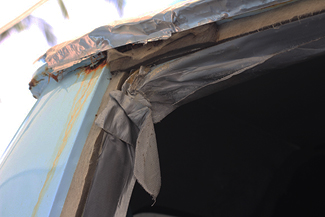 Salt water, rain, sun, and increasing demand have taken their toll on the van that has served as KBEC’s headquarters since the beginning.
Salt water, rain, sun, and increasing demand have taken their toll on the van that has served as KBEC’s headquarters since the beginning.“It is our hope that everyone who loves the bay will kōkua (support) by pledging to help us purchase the new mobile education unit. No donation is too small…every little bit adds up,” said Cindi Punihaole, KBEC program director. “The bigger vehicle will allow us to serve more visitors, rent out more snorkeling equipment, and create lifetime memories for our visitors while keeping the bay happy and healthy for generations.”
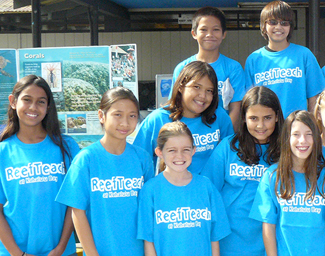 KBEC supports programs such as ReefTeach, which are essential to protecting and improving Kahalu‘u Bay’s fragile ecosystem.
KBEC supports programs such as ReefTeach, which are essential to protecting and improving Kahalu‘u Bay’s fragile ecosystem.Ducks and fences: An allegory of watershed interconnectivity
 An endangered koloa maoli, or Hawaiian duck. (Photo © U.S. Fish & Wildlife Service)
An endangered koloa maoli, or Hawaiian duck. (Photo © U.S. Fish & Wildlife Service)Funding from a North American Wetlands Conservation Act (NAWCA) grant through the U.S. Fish and Wildlife Service will be applied towards the Upper Laupāhoehoe Nui Watershed Reserve fencing project, with the specific intention of protecting the ducks’ habitat. This grant sets the precedent for recognizing KWP’s habitat restoration initiatives as critical to native wildlife protection.
More than ten other native species of duck have already gone extinct, making the koloa maoli the only surviving endemic duck in Hawai‘i. In 2002, the last time an official count was taken, the koloa maoli had a population of 2,200 individuals in the entire state; only 200 of those individuals were found on Hawai‘i Island. A more recent study of the ducks in the Lalakea watershed on Kohala Mountain found an average of 6.6 ducks per stream mile.
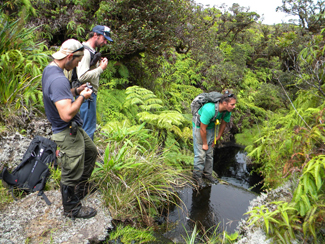 The KWP crew locates a potential stream crossing for the new fence to be installed at Laupāhoehoe Nui on windward Kohala Mountain. The landscape is crisscrossed with small perennial streams, which are ideal habitats for koloa maoli.
The KWP crew locates a potential stream crossing for the new fence to be installed at Laupāhoehoe Nui on windward Kohala Mountain. The landscape is crisscrossed with small perennial streams, which are ideal habitats for koloa maoli.Conservationists worry that the exposure of koloa duck populations to mallards will result in the loss of a genetically pure species of koloa. There are few, if any, mallards on Kohala Mountain, so the population of koloa in north Hawai‘i Island is less susceptible to genetic adulteration than ducks elsewhere, making it a very important population to protect. Despite the lack of genetic variation on Kohala Mountain, the koloa maoli are still threatened by diseases such as botulism, invasive predators including mongoose and rats, and habitat loss.
The koloa habitat consists of pools and streams found within the native Kohala wetlands, one of the last mountain wetland ecosystems remaining in Hawai‘i. The ducks particularly like waterfall-pool-waterfall complexes, which are abundant in the Upper Laupāhoehoe Nui Watershed Reserve. In fact, 25 miles of streams — all potential duck habitat — have been recorded in the reserve. KWP coordinator Melora Purell was “blown away” by the miles of streams once they were mapped. According to Purell, “For every stream shown on our previous map, there were at least three more too small to be recorded.” Currently, the wetland habitat is threatened by feral pigs, which trample and uproot native vegetation, and by invasive weeds, like Himalayan ginger, which can completely alter the structure of the ecosystem.
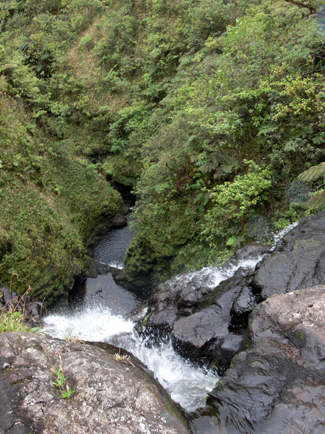 Kaimū Stream, one of the largest streams on windward Kohala Mountain. Waterfalls drop hundreds of feet into rocky pools – safe havens for koloa maoli.
Kaimū Stream, one of the largest streams on windward Kohala Mountain. Waterfalls drop hundreds of feet into rocky pools – safe havens for koloa maoli.In addition to habitat protection, KWP also plans to set up game cameras at different streams and pools in order to record the koloa in their habitat. “There aren’t much data about how many ducks exist or their behavior in the wild. A lot of what we know is speculative,” Purell said. She attributes this to the ducks’ shy behavior. “They spook easily. They hear people hiking towards them from a mile away and take off.” Since the remote koloa habitats in Kohala are accessible only by hiking or helicopter, game cameras will be the best way to observe ducks and gain more information about their population.
KWP intends to share this information with other researchers and collaborators working to protect the koloa. For example, Linda Elliott, president and director of the Hawai‘i Wildlife Center, hopes that the game camera footage will shed light on the ducks’ feeding behaviors, interactions with other species, and the threat of predation. According to Elliott, koloa maoli are “amazing birds, great parents, and loyal mates…those that get to see koloa in the wild are very fortunate, and we can hope that future generations will see more of them.”
The work funded by the NAWCA grant will emphasize the interconnectivity of KWP’s watershed conservation efforts. By targeting one facet of a watershed — in this case, protecting a wetland unit from feral pigs and invasive plants — other facets like the wetland’s stream health and duck populations will benefit. Focusing on stream quality in upland regions, and acknowledging that fencing can make a difference, adds a new element of importance to KWP’s conservation work. By awarding this grant, the U.S. Fish and Wildlife Service demonstrates its recognition of these watershed connections and the importance of fostering them.
^ back to top
United Nations International Year of Family Farming well timed for Hawai‘i
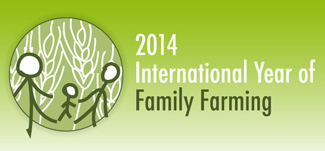 The United Nations has designated 2014 as the International Year of Family Farming.
The United Nations has designated 2014 as the International Year of Family Farming.During the 18th century, Hawai‘i Island produced enough food through agriculture, hunting, and fishing to support a million residents. Today, the island is home to less than 200,000 residents, or less than 15% of the state’s population, yet accounts for 63% of the state’s farmland. A Health Impact Assessment of the 2010 Hawai‘i County Agriculture Development Plan notes that the island’s “abundant fertile lands and a 12-month growing season create the potential for a high level of food self-reliance.”
Small family farms boast a number of benefits that could help Hawai‘i Island use this agricultural potential to regain food independence. For starters, small family farms use land efficiently. They often employ intercropping, a practice that involves growing diverse plants on the same land. In contrast, today’s larger commercial farms often grow single crops on vast tracts of land. This practice, called monocropping, requires less labor to plant, grow, and harvest a single crop; however, that efficiency comes at a cost. Each acre of monocropped land produces less food than each acre of intercropped land. A Food First policy brief on the benefits of small farms notes that small farms can be 200-1,000% more productive than large farms. Given the high cost of real estate and farmable land in Hawai‘i, efficient land use and high levels of productivity are critical to the long-term success of agricultural endeavors in the state.
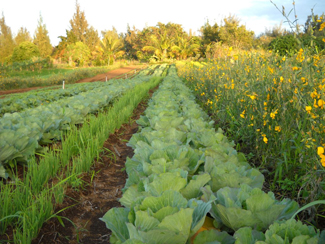 Small, diversified farms, such as this one in the Hāmākua district of Hawai‘i Island, hold strong potential to increase local food production, promote and maintain biodiversity, create jobs, and use farmland more efficiently.
Small, diversified farms, such as this one in the Hāmākua district of Hawai‘i Island, hold strong potential to increase local food production, promote and maintain biodiversity, create jobs, and use farmland more efficiently.Finally, small family farms create unique jobs. Farmers and their families who grow, harvest, and market their crops become entrepreneurs. They stand to gain valuable business and land management skills. The economy on Hawai‘i Island is largely based on tourism, which generates low-paying service industry jobs. Creating entrepreneurial opportunities in an economy primarily driven by tourism gives residents viable alternatives.
While small family farming in Hawai‘i may seem appealing, it is also subject to local challenges. Tourism and vacation real estate industries flourish on Hawai‘i Island, driving up land prices. Hawai‘i also faces the highest electricity prices in the United States and high costs of agricultural inputs shipped from the mainland. These factors impose steep costs on agricultural businesses. Access to useful and affordable consulting services is scarce. As a result, new farmers must learn their trade while juggling other business management responsibilities. Finally, major mainland agricultural corporations have the power to set prices and dominate markets, resulting in increased sales and distribution challenges for successful Hawai‘i farmers in local markets.
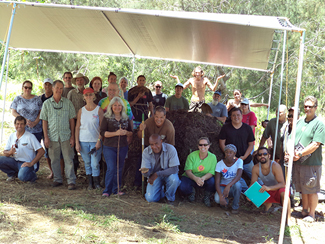 Farmer training programs, such as The Kohala Center’s Kū I Ka Māna Beginning Farmer-Rancher Development Program, ensure that a new generation of farmers is ready as many farmers reach retirement age.
Farmer training programs, such as The Kohala Center’s Kū I Ka Māna Beginning Farmer-Rancher Development Program, ensure that a new generation of farmers is ready as many farmers reach retirement age.Small-scale farmers often find success in banding together to create cooperatives. The Laulima Center, a program of The Kohala Center, works to expand and strengthen Hawai‘i’s rural economies and food systems by providing cooperative and business development services to farmers, value-added producers, and small businesses. The center assists in business formation, writing business plans, providing legal aid, and securing financing. For small farmers, these tools can be invaluable in creating stable and sustainable businesses. Says Laulima Center director Melanie Bondera, “On Hawai‘i Island, cooperatives allow small farmers to scale up together, access inputs, equipment, markets, and processing together, to achieve together what they otherwise could not achieve alone.” Cooperatives can give small farmers a competitive advantage in a marketplace of bigger players. Small, diversified family farms can collectively plug into a wider marketplace through a cooperative structure.
This year, family farmers on Hawai‘i Island will share common ground with peers from around the globe: the United Nations (UN) declared 2014 the International Year of Family Farming (IYFF). The UN hopes to elevate the profile of family farm operations and promote broad discussions at national, regional, and global levels. These discussions will address challenges facing farming families and identify efficient ways to support them.
For Hawai‘i Island, the movement is timely. Local family farmers will share in global recognition, support, and collaboration on the challenges they face. As a nonprofit already supporting local family farming efforts, The Kohala Center will use the added exposure from the IYFF to invigorate its current programs and contribute to the global conversation. These are important steps in strengthening the family farm movement on Hawai‘i Island.
A natural approach to increasing local food production
 Palili ‘O Kohala and the Natural Farming Learning Lab recently opened in Hāwī, North Kohala.
Palili ‘O Kohala and the Natural Farming Learning Lab recently opened in Hāwī, North Kohala.Once a vibrant agricultural region where Native Hawaiians farmed kalo (taro) as one of their primary staple crops, North Kohala is currently experiencing a resurgence in agricultural production, education, and entrepreneurship. Yet Native Hawaiians in the district are underrepresented as owners of agricultural businesses, and the district currently has no commercial kalo producers despite local and statewide market demand. One new, local cooperative is determined to change that — naturally.
Palili ‘O Kohala is a agricultural co-op comprised of ten Native Hawaiian families in North Kohala united to grow, process, and sell kalo and value-added food products derived from vegetables, pigs, and chickens. Based in Hāwī, the co-op will implement natural farming techniques to produce and distribute a variety of sustainably grown foods to local consumers at affordable prices.
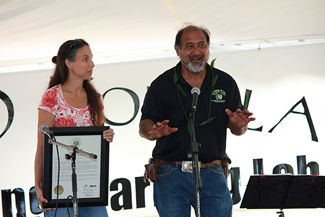 Andrea Dean and David Fuertes of Palili ‘O Kohala address a crowd of more than 100 attendees at the blessing of the program’s demonstration farm.
Andrea Dean and David Fuertes of Palili ‘O Kohala address a crowd of more than 100 attendees at the blessing of the program’s demonstration farm.Initially, the co-op plans to focus on products derived from kalo such as poi, kulolo, taro salad, steamed and frozen taro, taro leaf, and taro seedlings. The group intends to appeal to Native Hawaiian and Pacific Islander families on Hawai‘i Island at the outset, then market to a broader customer base as the output and variety of products increase.
According to Andrea Dean, Palili ‘O Kohala project director, the co-op will directly address three of the goals outlined in the district’s plan to create a productive, self-sufficient local food system. “Palili ‘O Kohala will create living-wage agricultural jobs in the local economy, revive the production of Native Hawaiian staple foods and food traditions in North Kohala, and create opportunities for community building and cultural engagement,” Dean said. “It will also incorporate an agricultural production system that some may see as revolutionary, but actually represents a return to more traditional practices that harness the natural resources that are already here.”
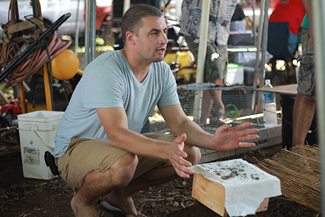 Chris Trump of Cho Global Natural Farming Cooperative gives a demonstration on how to cultivate indigenous microorganisms.
Chris Trump of Cho Global Natural Farming Cooperative gives a demonstration on how to cultivate indigenous microorganisms.The Learning Lab opened to the public in early March of this year with a blessing and several workshops and demonstrations. Chris Trump, a North Kohala macadamia nut farmer and vice president of Cho Global Natural Farming Cooperative, led an Introduction to Natural Farming workshop and compared the approach to what occurs naturally in the wilderness. “When you go into a forest, the vegetation is healthy and verdant, and the soil is typically loose, moist, and rich in organic matter,” Trump said. “This happens without the use of any fertilizers or pesticides — it’s simply nature’s design. Natural farming works on the same basic premise: it harnesses and cultivates healthy soil ecology to grow food at a low cost.” Natural farming methods can be applied beyond just fruits and vegetables: they’re also effective for raising livestock. The Natural Farming Learning Lab features a demonstration chicken house and a piggery, and the use of IMOs in the floor litter works to break down animal waste. This in turn results in a significant reduction of odor, the production of natural fertilizer, and a healthier environment for the animals.
The Laulima Center assisted the Cho Global Natural Farming Cooperative in 2012 with cooperative formation, business design, group development, business planning, and grant writing. The center is supporting the co-op again this year through the current USDA grant by helping the group to plan and conduct a weeklong training course for aspiring natural farmers. The course will be held June 17 through 21 at the University of the Nations in Kailua-Kona; students who complete the course will obtain natural farming certification from the co-op and the University of Hawai‘i at Hilo. More information and registration is available online at http://naturalfarming14.eventbrite.com.
Community leaders convene in Waimea to advance hope for Hawai‘i’s keiki
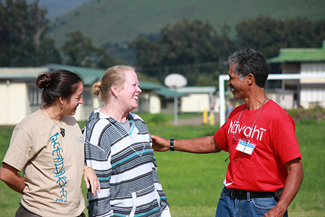 Malia Greaney and Kathy Morris of Hui Mālama o Ke Kai and Aliʻi Hauanio of Ke Kula ʻO Nāwahīokalaniʻōpuʻu share a moment as partners in Hau‘oli Mau Loa Foundation’s “Hope for Kids” initiative convened in Waimea for a day of team building, networking, and learning.
Malia Greaney and Kathy Morris of Hui Mālama o Ke Kai and Aliʻi Hauanio of Ke Kula ʻO Nāwahīokalaniʻōpuʻu share a moment as partners in Hau‘oli Mau Loa Foundation’s “Hope for Kids” initiative convened in Waimea for a day of team building, networking, and learning.HISGN program director Nancy Redfeather organized this year’s Hope for Kids Partner Convening, assisted by Māla‘ai program director Amanda Rieux, executive director Alethea Lai, and garden leader Holly Sargeant Green. Holding this year’s convening event at Māla‘ai meant the shared learning revolved around school gardens, networking, and making connections with schools, families, communities, and students. There was also an emphasis on sense of place: understanding where you are and where you come from.
“The Hope for Kids annual gatherings provide opportunities for partners to participate in activities and share knowledge about topics that they can then take back and apply within their own organizations,” said Keahi Makaimoku, program associate at Hau‘oli Mau Loa Foundation. “The partners also gained valuable insights during the hands-on work time in the garden, networking discussions, and the more informal opportunities to reconnect with one another.” The gathering also provided an important moment for participants to reflect on personal sustainability and renewal, and they found much inspiration in reflections from esteemed leaders Uncle Jerry Konanui and Kumu Pua Case.
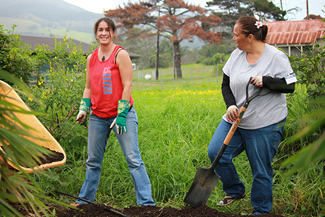 Hope for Kids partners spent part of their day working together at Māla‘ai: The Culinary Garden of Waimea Middle School.
Hope for Kids partners spent part of their day working together at Māla‘ai: The Culinary Garden of Waimea Middle School.Convening the Hope for Kids partners to share experiences and knowledge with each other was initially an experiment. “We weren’t certain that it would have value for the partners and certainly didn’t want to take their time for something which didn’t add to their work,” noted Janis Reischmann, Hau‘oli Mau Loa’s executive director. Over the past several years, however, “we have been convinced, both by what the partners say and what we observe, that bringing the group together to share with each other is inspiring as well as productive. We are deeply grateful to all contributors who made this convening at Māla‘ai another rewarding and valuable experience for everyone who participated.”
Elysa Ermatinger, program coordinator with Hoa ‘Āina O Mākaha on O‘ahu, agreed. “Over the years we have become an ‘ohana that shares mana‘o (thoughts, ideas), provides each other with support and encouragement, and inspires one another with the many talents within the group,” she said. “Sharing two days with such passionate individuals and organizations is so important for the rejuvenation of our minds and reawakening of our spirits.”
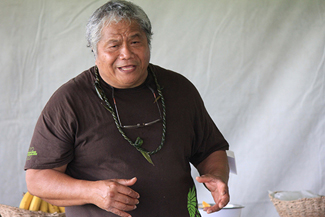 Jerry Konanui, a kalo (taro) farmer and cultural practitioner, speaks to Hope for Kids partners about Hawaiian food plants and opportunities to teach children about them.
Jerry Konanui, a kalo (taro) farmer and cultural practitioner, speaks to Hope for Kids partners about Hawaiian food plants and opportunities to teach children about them. Mahalo to Chef ‘Ōlelo pa‘a Faith Ogawa, Lilikoi Cafe, FoodCorps Hawai‘i, and Kumu Pua Case and Jerry Konanui for their assistance with this special event.


